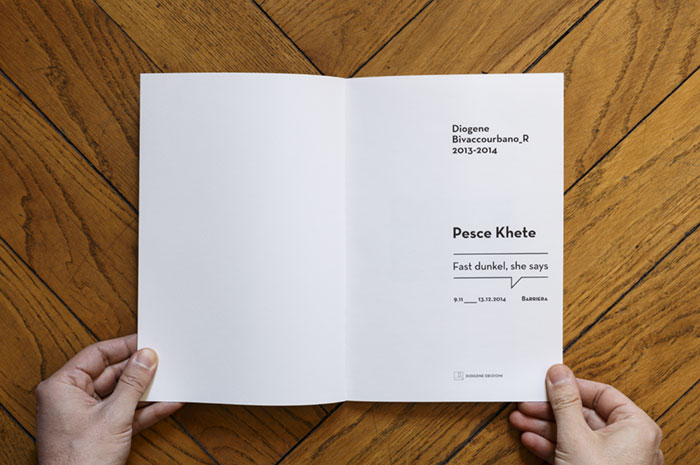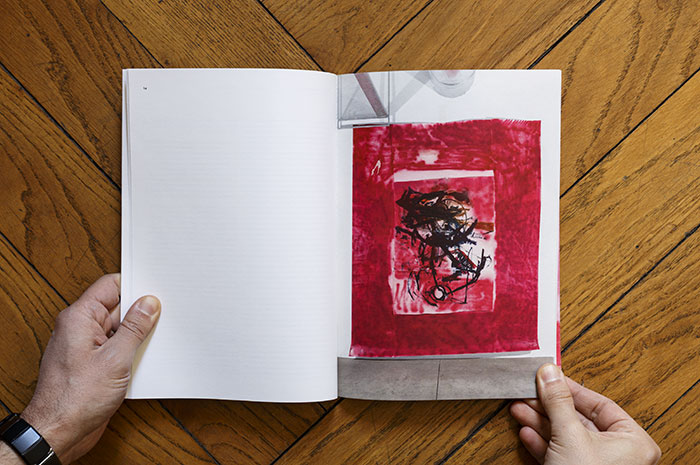Lost Futures
Essay in Pesce Khete. Fast dunkel, she says, Diogene Edizioni, Turin 2014.
Fast dunkel, she says was a solo show of the Swiss-Italian artist Pesce Khete as the final exhibition of the residency program Bivaccourbano_R of Progetto Diogene.
The exhibition was hosted at Associazione Barriera from 9 November 9 to December 13, 2014 and during Colazione a Barriera – an event which took place each year during Artissima Art Fair at Barriera venue – was presented the catalogue, curated by Diogene.



Lost Futures
Everything that exists is possible only on the basis of a whole series of absences. Mark Fisher [1]
Art as a wager and not art as a search for truth. Which is not postmodernism. It is raising the stakes in relation to this, taking the shape of unscrupulous eclecticism while removing it from the eminently formal sphere; it is the pleasure of the risk of freedom. Corrado Levi [2]
Sapphire and Steel, are the names of the two ‘time detectives’ in charge of safeguarding the present time from dangerous raids coming from other space-time hemispheres. This is what happens in the visionary British series that aired from 1979 to 1982. In one of the first assignments, the male protagonist, Steel, explains the mechanism that generates these irregularities: “temporal anomalies triggered by the predilection of humans for mixing artifacts from different eras.”
It is with this television series and, in particular, with the final image in which the two detectives are stuck in a time capsule (a forties-style cafeteria) wandering in space, that Mark Fisher begins his recently published book, Ghosts of My Life.
And to confirm that his – personal – ghosts are the same as those of an era that has lived through the transformation, but which in the balance between two generations, can only perpetuate the compulsion of repetition (personal, social, cultural), ascertaining the absence of a temporal linearity and, at the same time not resigning himself to it, concludes his brilliant first chapter, entitled Lost Futures, with the revelation of the theft of the title of his book.
There is no more need for originality at all in fact. One can quote and steal, but without any bragging nor claiming the right of ignorance. It is no longer time to play hide and seek and pass off our actions and creations as being random.
Ghosts of My Life is a direct quote, albeit digested and fully customized, from the eponymous EP by Rufige Kru – later Goldie – bought by Fisher in 1994. Ghosts of My Life also reminds the author of when he recorded Ghosts by Japan off the radio in 1982, and repeatedly listened to the track in a mnemonic loop whose echo then came back 14 years later, in the first single by Tricky, Aftermath.
For the generation born between the late Seventies and early Eighties, who still remembers those bold television programs with their disturbing non-truths, which were formed by absolutely totalitarian predecessors in their belief of an inevitable linear succession of novelties and discoveries, it is very difficult to let go of those ghosts. Despite the maddening certainty of the simultaneity of time, of the acceleration of information as well as the slowing down if not outright halting of culture, there is a willful and melancholy innate repetition of a glorious past.
This is visible in the cultural manifestations and it is evident in the field of popular music. There are no longer any isms (for a while now) because there isn’t a past to counteract them; there are no longer any parents to rebel against. Therefore, we nostalgically return to the twentieth century and take everything from that illustrious past that has the charm of the being “vintage”.
There are those who regard this return to past as simply ‘formal’, where quoting it is something to be tossed off with disregard, given its blatant origin.
There are actually those who are still convinced that the new can come back and lament the dead, without even thinking of at least beginning to elaborate any bereavement.
Pesce Khete, whose first name means “fish” in Italian, was born in 1980 and he loves to create confusion, on every level. His work reflects an apparent chaos because it is based on the combination of reason-instinct that each of us faces every infernal second of our lives. Here the problem is that the combination is often difficult to detect in that it is reversed.
His paintings which seem to be more expressive and gestural (and therefore considered as ‘true’) are, in fact, the most calibrated and meditated of his production. His research is probably based on this fascinating paradox.
If we were to include Khete’s work among the New Casualists, as defined by Sharon L. Butler in 2011 [3] or glimpse traces of it in Provisional Painting by Raphael Rubinstein [4], we would probably be approaching it the wrong way, because, like that of many other contemporary painters, his work steals from the past (historical and personal) in a way that is both conscious and random, daily dealing with the most historical and historicized mediums, such as painting and photography, precisely to challenge himself and his knowledge, as well as his impulses.
First of all, the peculiarity of Pesce Khete begins with his name, a fake name, a nickname. This is an idea that is also very twentieth century, you could say, but one that immediately arouses some ambivalence. It is a name that says everything and nothing, which is destabilizing by its concomitant presence of seriousness and humor and which spontaneously rings true in a gesture, namely the automatic text message correction on cell phones of a word now lost. So the artist gets the chance to say everything and anything, to be homeless.
His approach to painting and photography is ephemeral. He uses oil stick and spray paint on cotton paper and does not worry at all about how a particular painting is then stored. He makes paper prints of analog negatives whose images are enlarged and sometimes desaturated.
He is obsessed by time. He is attracted by the narrative but continually tries to delete it. Painting on a small desk, he imposes on himself only a fraction of the time and a portion of the space within which to paint; then he add other papers: white if there needs to be some air; otherwise scraps of old discarded paintings, if his eye starts to combine past and present, finding a continuity that is both formal and semantic.
The papers are joined by adhesive tape, whereas, in order to correct the dominant color if he is no longer convinced, he makes abundant use of color spray paint, which can completely blot out and shift everything, thus immobilizing and keeping the past hidden.
His painting has recently been delegated with the honor of abstraction, whereas his photography concerns the image.
This balance and these different roles, almost didactic of the two mediums, had been overthrown in 2011, for the exhibition on the river (The Flat-Massimo Carasi Gallery, Milan), when his paintings were still landscapes.
However, on that occasion, he realized that by repeating a particular shot manually on paper he could get a series that was ‘almost’ the same. And today he constantly wonders how come the same subject and the same shot never result the same negative, and not only when taken by a different person.
Therefore, he wonders how it is possible to mechanize painting and “manualize” photography.
Smitten by these continuous reflections, so as not to be overwhelmed by a use of painting that is too personal and salacious, and of photography that is too specialized and illustrative, he imposes rules on himself because he is aware that, within a certain method, it is possible to take a risk and that, upon taking it, new solutions can be discovered.
In this period, Khete almost seems to no longer be frightened by any narrative that can also be given to a simple combination of two sheets stuck together. He has surrendered to the evidence that, in any case, any kind of mark at all comes from a memory of a figure or the exaltation of a shape.
For the exhibition Fast dunkel, she says at the Barriera space in Turin, at the conclusion of his residency with Diogenes’ Bivaccourbano conducted in 2013, the artist cannot help but think back to that experience, reusing those notes from some time ago. This has happened on instinct, as his intuition tells him that he can now not only and not so much match the photographs to find the right balance with the paintings but in turn, these can be of any shape (there was a certain prevalence of the vertical in his past exhibitions), containing the echoes of patches ripped from previous work, the vertigo of a view from above, and the falling into the void of the horizon.
The apparent fragility with which his works are made reveals a waiver of immortality that is absolutely common in the artists of his generation. The fear is now elsewhere, lying in the lack of perspective and future.
Khete is trying to restore that perspective to himself and to the viewers in every single exhibition where, moving through the space, one adds air and removes vision. Walking and moving within a setting where various works interact with each other and experiencing the exhibition’s pathway, one is reminded of the exhibition at the PAC in Milan in 1986, conceived and curated by Corrado Levi. It was called Il Cangiante, i.e. the iridescent color that changes suddenly, without any intermediate ways, as soon as it moves, even slightly.
This is why it is impossible to know what experience and what landscape there will be at the Barriera space. Until the end of the mounting of the exhibition, no one knows, not even Pesce. But then again, isn’t the surface of fish, with their scales, iridescent?
Manuela Pacella
[1] Mark Fisher, Ghosts of My Life. Writings on Depression, Hauntology and Lost Futures, Zero Books, Winchester, UK-Washington, USA 2014, p.18.
[2] Corrado Levi, Diario in Il Cangiante (The Iridescent), Section 4. Ruins of Exhibitions, “Nero”, N. 34, Spring 2014, p. 152.
[3] Sharon L. Butler, Abstract Painting: The New Casualists in “The Brooklyn Rail”, June 3 2011.
[4] Raphael Rubinstein, Provisional Painting in “Art in America”, May 4 2009; Provisional Painting, curated by Raphael Rubinstein, Modern Art, London, 15 April – 21 May 2011; Raphael Rubinstein, Provisional Painting 2: To rest Lightly on Earth in “Art in America”, February 01, 2012.